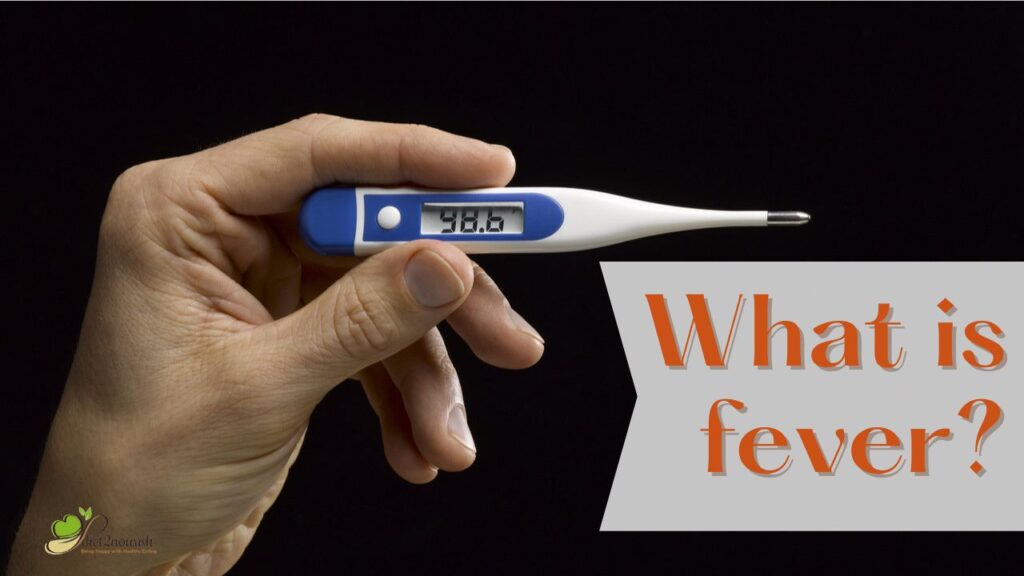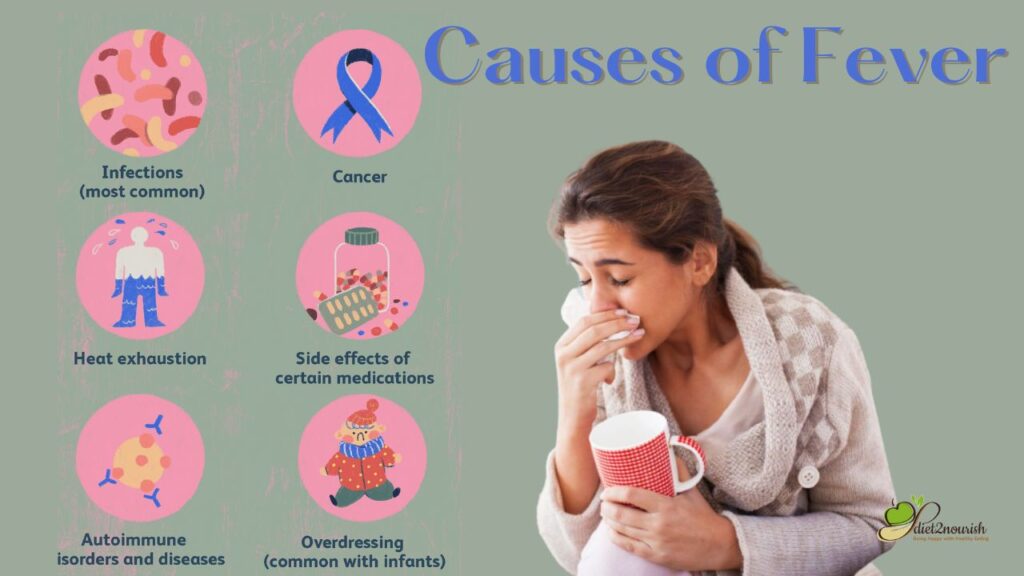Fever Diet
Fever diet, like any other diet is a program to help you get a better quality of life.Many people are unfamiliar with the term lifestyle disease. In simpler terms, lifestyle disease can be described as confident choices we make in our day-to-day life that impacts our health either directly or indirectly. There are multiple lifestyle diseases such as asthma, diabetes, hypertension, liver disease, gastroenteritis, infections, etc.
These diseases weaken the body’s immune system, which has various symptoms like fever, nausea, vomiting, and dizziness, to name a few. You can prevent such types of lifestyle diseases by making certain modifications in diet and lifestyle habits. It has to be acknowledged that good health is all about taking charge and striking a perfect balance between a balanced diet and physical activity.
What is fever?

Fever is not a disease but a symptom of an underlying ailment that results in a temporary increase in body temperature. The body temperature of a healthy adult under normal circumstances should be around 98.4°F (37°C). An increase in body temperature above the normal range can be fever. Fever is usually a natural response of the body’s immune system to ward off infections caused by different types of viruses and bacteria. Apart from medications, you can also follow fever diet for quick recovery.
Fever can be categorized as a low-grade, moderate, or high-grade fever. Some of the most common symptoms associated with fever include:
- Pain in the body, especially the joints
- Loss of appetite
- Fatigue
- Chills
- Headache
- Nausea
In some cases, a very high fever can cause some severe complications like seizures, strokes, etc.
Causes of Fever

An area in the brain, the hypothalamus, works as a thermostat. It maintains the balance between the heat produced by the body and heat lost.
Some of the leading causes in which the hypothalamus elevates the body temperature causing a fever are:
- Infections caused by different types of viruses or bacteria
- Heat exhaustion.
- Joint inflammation
- Cancer and cancer treatments
- Hormonal imbalance
- Side effects of some medications.
Certain complications are linked with a high-grade fever. These are seizures, stroke, and organ damage. In addition, if the body’s temperature rises above the normal range [97°F (36.1°C) to 99°F (37.2°C)], you must immediately rush to the physician.
Treatment of fever:
The treatment of fever highly depends on the underlying cause of the fever. If you have a fever in response to a body infection, a suitable antibiotic and an antipyretic medicine would be beneficial in lowering the body temperature. Moreover, a wholesome fever diet and proper body hydration play a crucial role in combating fever. Managing adequate hygiene and washing hands properly helps to prevent fever from infections.
Food to Eat During Fever:
When a person is unwell due to fever, they suffer from extreme loss of appetite, and eating food may be one of the minor things in your mind. However, when a person has a fever, the rate of burning calories and, therefore, the body needs more calories to tackle the ill effects of fever. Hence, a wholesome fever diet is crucial for the body to function correctly. This article lists food to eat during a fever that will aid in speedy recovery.
- Clear chicken soup is one of the best comfort foods to eat during fever. Fever may cause dehydration due to loss of body fluids and electrolyte imbalance. Chicken soup nourishes the body by rehydrating it along with balancing the electrolyte levels in the body. Chicken soup with different spices, and celery leaves, spring onions, are full of flavors that help in enhancing your appetite and are easy to digest in your gut. It is a wholesome food for fever that is extremely rich in proteins and different types of vitamins and minerals. Moreover, the chicken contains cysteine, an essential amino acid that reduces inflammation and provides warmth to the body.
- Oatmeal is easy to digest and a very healthy option for a vegetarian fever diet. Oatmeal is rich in fibers. A bowl of oatmeal contains immune-boosting nutrients like beta-glucan and zinc, which helps to fight fever-causing bacteria or virus. Consume oats with milk as in the traditional way. You can certainly make your oatmeal a twist in a savory form that will tickle your taste buds during fever. The recipe for Oats Poha that is mouth-watering and healthy for a fever diet is listed below.
- Sprinkle the rolled oats with a few drops of water until they are soft but not soggy.
- Put one tablespoon of olive oil in a pan and sauté some vegetables of your choice.
- After cooking the vegetables for some time, add a pinch of turmeric, black pepper, and a bit of salt to the vegetables.
- The next step is to add the rolled oats to the pan
- Add water and cover the pan until the water absorbs.
- You can also add a few drops of lemon juice.
It is a tasty and healthy oatmeal recipe of food for fever that you can try to regenerate your taste buds during fever.
- Besan Sheera: If you are suffering from fever along with cough and cold, Besan sheera is a traditional Indian recipe that will bring relief from the uneasiness due to fever. It is also a part of the vegetarian fever diet that has numerous benefits ranging from soothing a sore throat to bringing relief from fever. It is a simple and effective recipe for fever requiring very few ingredients that are available in every household.
Recipe:
- Put ghee or clarified butter in a pan.
- Once the ghee is hot, incorporate the besan into the pan and keep stirring until the besan is cooked and becomes slightly brown.
- The next step is to add milk. Again, add the milk in small batches to avoid lump formation.
- Now add black pepper powder and turmeric to the pan. Both of these spices have numerous medicinal properties.
- Allow the mixture to come to a boil.
- Once it is cooked, you can consume it hot.
- Khichdi: Khichdi is one of the best wholesome meals. It is incredibly healthy and quintessential food for fever. It is easy to digest and is bundled with the carbohydrate from rice and proteins from the dal. To enhance the taste and nutrient value, add some vegetables to the khichdi, like potatoes, carrots, etc. Khichdi can be paired with healthy condiments, like mint chutney and yogurt. Usually, during fever, there is a mildly bitter taste in the mouth. You can sprinkle a few drops of lemon juice over khichdi to neutralize the bitter taste. You can enjoy every morsel of your khichdi as a part of your fever diet.
- Yogurt: Doctors and dieticians may suggest including yogurt as a part of the fever diet for a speedy recovery. Yogurt, especially the unflavoured, is a probiotic enriched with good bacteria that help ward off the infection-causing bacteria. It is also a rich source of protein and calcium that is important for the body’s overall well-being. Moreover, yogurt combined with spices like sautéed cumin and asafoetida will help boost your appetite, which is almost non-existent during fever.
Vegetarian food to Eat during Fever:
During fever, your hemoglobin levels might drop slightly, and you may suffer from anemia due to malnutrition from loss of appetite. To replenish the loss and maintain adequate hemoglobin levels, incorporate green leafy vegetables (spinach, kale, fenugreek leaves) into your fever diet. These are rich plant-based sources of iron and vitamins. In addition, dark green vegetables like bottle guard, a vegetable broth made of carrots, tomatoes, celery, and cauliflower can be prepared and consumed as a part of a fever diet.
Fruits to eat during Fever:
Fruits are packed with antioxidants and essential types of vitamins and minerals that help in the process of a speedy recovery.
- Bananas are soft and bland, making them easy to digest during fever. In addition, bananas are rich in potassium which helps to replenish the loss of potassium and electrolyte imbalance during fever. Apart from potassium, banana also contains vitamins and carbohydrates that provide the required energy to stay active during fever.
- Avocados are excellent foods to eat with a fever because they contain a healthy fat called oleic acid, which is anti-inflammatory. The gut quickly digests avocados as they are bland and equally tasty. Consume avocados in the form of salads and sandwiches.
- A popular saying goes, “An apple a day keeps the doctor away.” Apples are a great source of antioxidants and protective nutrients. If you consume one apple a day, you get the benefits of 1500mg of Vitamin C in your diet. Apple is undoubtedly an all-in-one fruit that you need when you are sick.
Foods to Avoid During Fever
- Caffeinated Drinks: During a fever, your body loses fluids due to elevated temperature. Caffeinated drinks like tea and coffee are diuretics that will worsen your symptoms and dehydrate your body when you have a fever.
- Alcohol: Consuming alcohol can cause an upset stomach and dehydration. It can also lower the immune system.
- Sugary Foods: Avoid foods packed with sugars and artificial sweeteners during the fever. These foods are hard on the digestive system. Moreover, excessive sugar can cause inflammation that might hamper your healing process. So even if you have a sweet tooth, that large piece of cake or hot jalebis are the foods to avoid during fever.
- Processed foods have fewer nutrients. So when the body is trying to heal itself, it’s crucial to support the process with whole, nutritious foods.
Summary:
Foods are supportive therapy that aids in your healing process. Following a proper fever diet combined with medicines can help you bounce back from your Fever within a few days. Adequate nutrition is a must to help you recover from a fever. A balanced fever diet and proper hydration should be maintained for overall well-being while combating Fever.









